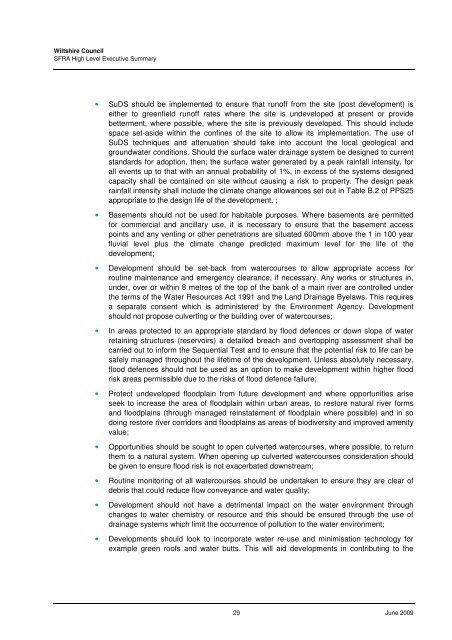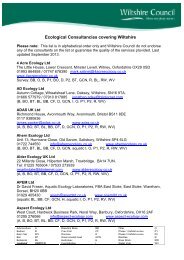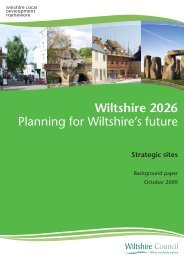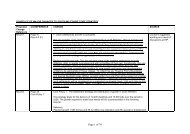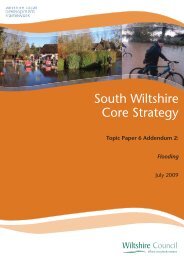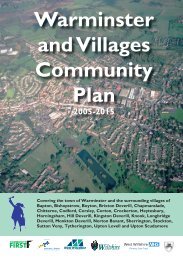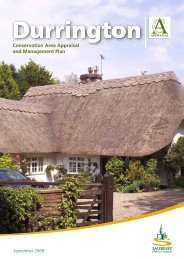Strategic Flood Risk Assessment - Wiltshire Council
Strategic Flood Risk Assessment - Wiltshire Council
Strategic Flood Risk Assessment - Wiltshire Council
Create successful ePaper yourself
Turn your PDF publications into a flip-book with our unique Google optimized e-Paper software.
<strong>Wiltshire</strong> <strong>Council</strong>SFRA High Level Executive Summary• SuDS should be implemented to ensure that runoff from the site (post development) iseither to greenfield runoff rates where the site is undeveloped at present or providebetterment, where possible, where the site is previously developed. This should includespace set-aside within the confines of the site to allow its implementation. The use ofSuDS techniques and attenuation should take into account the local geological andgroundwater conditions. Should the surface water drainage system be designed to currentstandards for adoption, then; the surface water generated by a peak rainfall intensity, forall events up to that with an annual probability of 1%, in excess of the systems designedcapacity shall be contained on site without causing a risk to property. The design peakrainfall intensity shall include the climate change allowances set out in Table B.2 of PPS25appropriate to the design life of the development. ;• Basements should not be used for habitable purposes. Where basements are permittedfor commercial and ancillary use, it is necessary to ensure that the basement accesspoints and any venting or other penetrations are situated 600mm above the 1 in 100 yearfluvial level plus the climate change predicted maximum level for the life of thedevelopment;• Development should be set-back from watercourses to allow appropriate access forroutine maintenance and emergency clearance, if necessary. Any works or structures in,under, over or within 8 metres of the top of the bank of a main river are controlled underthe terms of the Water Resources Act 1991 and the Land Drainage Byelaws. This requiresa separate consent which is administered by the Environment Agency. Developmentshould not propose culverting or the building over of watercourses;• In areas protected to an appropriate standard by flood defences or down slope of waterretaining structures (reservoirs) a detailed breach and overtopping assessment shall becarried out to inform the Sequential Test and to ensure that the potential risk to life can besafely managed throughout the lifetime of the development. Unless absolutely necessary,flood defences should not be used as an option to make development within higher floodrisk areas permissible due to the risks of flood defence failure;• Protect undeveloped floodplain from future development and where opportunities ariseseek to increase the area of floodplain within urban areas, to restore natural river formsand floodplains (through managed reinstatement of floodplain where possible) and in sodoing restore river corridors and floodplains as areas of biodiversity and improved amenityvalue;• Opportunities should be sought to open culverted watercourses, where possible, to returnthem to a natural system. When opening up culverted watercourses consideration shouldbe given to ensure flood risk is not exacerbated downstream;• Routine monitoring of all watercourses should be undertaken to ensure they are clear ofdebris that could reduce flow conveyance and water quality;• Development should not have a detrimental impact on the water environment throughchanges to water chemistry or resource and this should be ensured through the use ofdrainage systems which limit the occurrence of pollution to the water environment;• Developments should look to incorporate water re-use and minimisation technology forexample green roofs and water butts. This will aid developments in contributing to the29 June 2009


